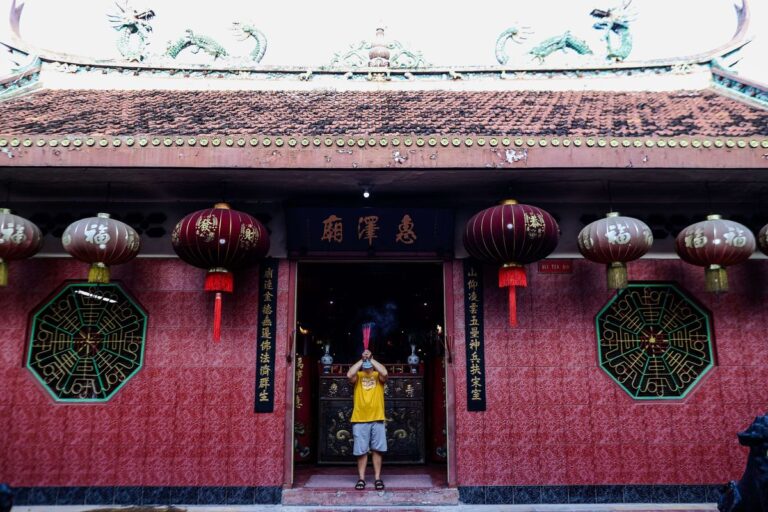Vihara Dharma Bhakti: The Oldest Chinese Temple in Jakarta’s Chinatown
Jakarta, the vibrant capital city of Indonesia, is home to a diverse array of cultures and religions. Among them, the Chinese community has played a significant role in shaping the city’s history and identity. With more than 140 Chinese temples scattered across Jakarta, one stands out as the oldest and most revered – Vihara Dharma Bhakti in Petak Sembilan, also known as Glodok.
A Glimpse into History
Vihara Dharma Bhakti was originally constructed in 1650 by Chinese lieutenant Kwee Hoen. At that time, it was called Koan Im Teng, dedicated to the goddess Kwan Im. However, throughout its long history, this Taoist temple underwent several name changes. In 1740, during a horrific massacre by the Dutch, the temple was destroyed. It was later rebuilt in 1755 by Chinese captain Oei Tjhie and named Kim Tek Le or Jin De Yuan, which translates to “golden wisdom” in English. Eventually, its name was translated into Bahasa Indonesia and became known as Vihara Dharma Bhakti.
A Place of Worship
Situated on Jalan Kemenangan III behind Jalan Gajah Mada, Vihara Dharma Bhakti covers an area of 3000 square meters. Despite its age, the temple continues to attract a large number of devotees who come to seek protection from the Almighty and pray for prosperity. Particularly during Chinese New Year celebrations when devotion reaches its peak, this temple becomes a focal point for worshippers.
To reach the main temple building, visitors pass through three smaller temples adorned with red lanterns hanging from their ceilings. Each section of these smaller temples houses altars dedicated to different deities. Before entering the main temple, visitors have the opportunity to burn incense sticks called Hio and pray to the Highest Creator. They then place the incense in a large bronze bowl known as Hio-louw or incense receptacle. On special days, the air in the plaza is filled with smoke and the aroma of incense.
The Magnificence of Vihara Dharma Bhakti
The prayer hall within Vihara Dharma Bhakti is a sight to behold. Four red pillars support a double ceiling adorned with yellow motifs and crowned with a water lily bud. Rows of burning red candles line one wall, while dozens of giant red candles stand prominently in the middle of the hall. The sunlight streaming through the ceiling adds a unique aura to the rising smoke within the temple.
On another side of the wall, one can find bronze statues depicting various deities. These statues represent Taoism, Confucianism, and Buddhism, reflecting Vihara Dharma Bhakti’s adherence to Buddhist Mahayana faith. As visitors explore this ancient Chinese temple, they are captivated by intricate carvings, exquisite calligraphy around pillars, and paintings of dragons and swallows – all masterpieces created by artists centuries ago.
Nearby Temples: Vihara Tanda Bhakti and Vihara Dharma Jaya
Adjacent to Vihara Dharma Bhakti are two other significant Chinese temples that are worth visiting – Vihara Tanda Bhakti and Vihara Dharma Jaya (Toasebio). These temples are located within walking distance from each other.
Vihara Dharma Jaya (Toasebio), which is 259 years old, stands out with its bright red exterior. Its roof is adorned with intricate dragon and bird motifs. Behind its original building lies a new two-storey construction that accommodates a large congregation during prayer times. The hall is adorned with lanterns hanging from the ceiling, and altars are placed strategically around the temple. Rows of neatly arranged candles add to the serene ambiance.
Built three years after Vihara Dharma Jaya, Vihara Tanda Bhakti boasts a commanding presence. Its pillars and ceiling are dominated by red and yellow colors. This temple’s architecture exudes grandeur and elegance.
How to Get There
For those interested in visiting these temples, Petak Sembilan is conveniently located near Jakarta Kota Station. From there, various local transport options such as angkot, metromini, ojek motorbike taxi, Transjakarta bus, or three-wheeled bajaj can be used. If you’re departing from Kota Station (also known as Stasiun Beos), take any transport heading to Tanah Abang.
Upon arriving at Glodok station, visitors can easily walk to Pancoran Market or Asemka market. To reach Jalan Kemenangan where Jakarta’s oldest Chinese temples are situated, turn left at the first street leading to Asemka.
Preserving History and Spirituality
Vihara Dharma Bhakti and its neighboring temples serve as a testament to Jakarta’s rich cultural heritage. They stand as reminders of the city’s Chinese community’s contributions throughout history. These ancient temples provide a place for worshipers to connect with their spiritual beliefs in an atmosphere that exudes tranquility and reverence.
Whether you are seeking blessings or simply exploring Jakarta’s oldest Chinese temples, take a moment to appreciate the intricate craftsmanship and artistic beauty that has endured for centuries within these sacred spaces.



